Prolific French actor Léon Mathot (1886-1968) became well-known for his role of Edmond Dantès in the French silent serial Le comte de Monte Christo/The Count of Monte Christo (1918). He is also known for his role in two classic silent films by Jean Epstein, Coeur fidèle/The Faithful Heart (1923) and L’Auberge Rouge/The Red Inn (1923). In 1927 he turned director and directed over 20 films in all genres until 1953.
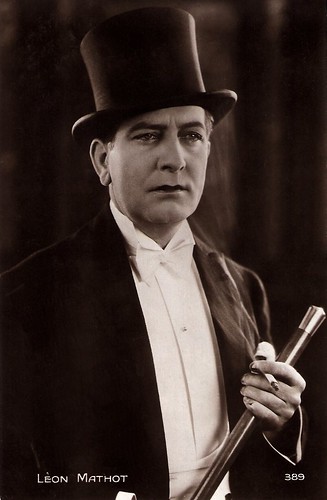
French postcard by Cinémagazine-Edition, Paris, no. 389.
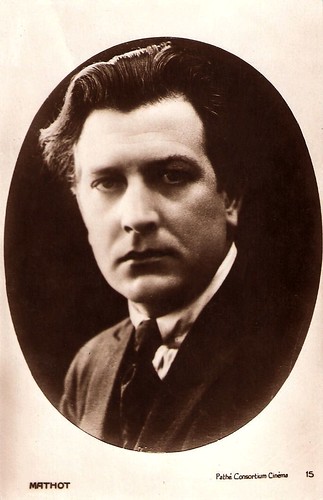
French postcard by Cinémagazine-Edition, no. 15. Photo: Pathé Consortium Cinéma.
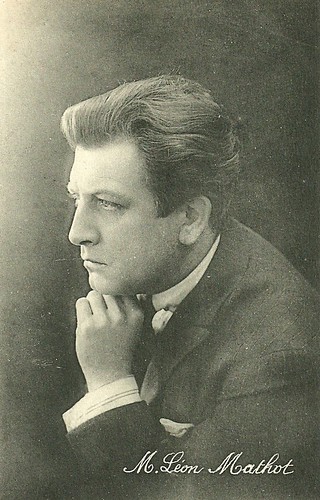
French postcard by M. Le Deley, Paris. Photo: Pathé Consortium Cinéma. Publicity still for L'empereur des pauvres/The Emperor of the poor (René Leprince, 1921).
Léon Désiré Joseph Mathot was born in Roubaix, France in 1886. After passing his youth in Liège, Belgium, and following the Conservatory there, he started to play on stage in Lyon, and later in Brussels and Paris.
Thanks to his friend Lucien Nonguet who shot short comedies at Pathé, Mathot started in cinema in 1906 as an extra. His first appearance was in the short and silent André Deed comedy La course à la perruque/The Wig Chase (Georges Hatot, André Heuzé, 1906).
Between 1911 and 1914 he played in dozens of the Gontran comedies, often directed by Lucien Nonguet. He also played in dramatic films by directors Henri Andréani and Alfred Machin, mainly for the Belge-Cinéma. During the First World War Mathot switched to the Film d’Art company, where he worked with the young director Abel Gance, such as in Les gaz mortels/Mortal gases (Abel Gance, 1916).
His collaboration with Henri Pouctal started with the film Volonté/Will (Henri Pouctal, 1917) and culminated in the serial Le comte de Monte Christo/The Count of Monte Christo (Henri Pouctal, 1917-1918), which made Mathot an overnight star. Mathot played Edmond Dantès, the leading character in Alexandre Dumas’ classic novel. Dantès takes revenge on the people who ruined and imprisoned him, after he has come into possession of a huge treasure and a new identity.
This success was followed by other films by Pouctal like Travail/Work (Henri Pouctal, 1919), a film in seven chapters taking place at a steel factory, in which Mathot again had the male lead, opposite Huguette Duflos.
Mathot’s reputation only grew during the 1920s while playing in popular French silent films like L'ami Fritz/The Friend Fritz (René Hervil, 1920) again with Duflos, the serial L'empereur des pauvres/The emperor of the poor (René Leprince, 1922) with Gina Relly, the classic drama Cœur fidèle/The Faithful Heart (Jean Epstein, 1923) with Gina Manès, the Honoré de Balzac adaptation L’Auberge Rouge/The Red Inn (Jean Epstein, 1923) again with Manès, Mon oncle Benjamin/My Uncle Benjamin (René Leprince, 1923), Le puits de Jacob/A Daughter of Israel (Edward José, 1926) with American star Betty Blythe, Le mystère de la Villa Rose/Mystery of the Pink Villa (René Hervil, Louis Mercanton, 1930), and La maison de la flèche/The house of the arrow (Henri Fescourt, 1930) with Annabella.
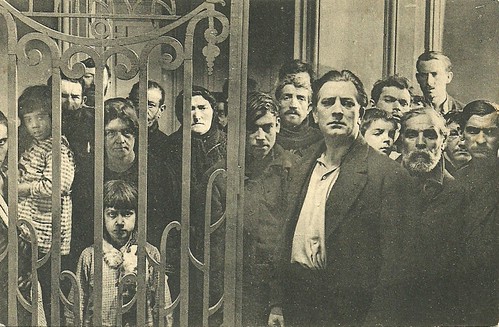
French postcard by M. Le Deley, Paris. Photo: Pathé Consortium Cinéma. Publicity still for L'empereur des pauvres/The Emperor of the poor (René Leprince, 1921). Standing front, Léon Mathot.
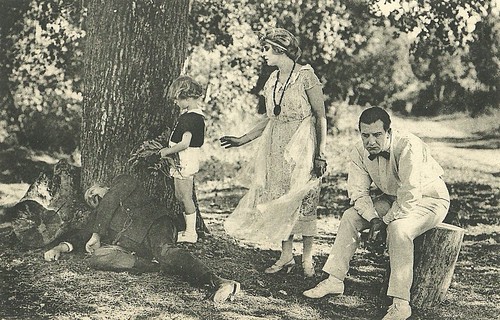
French postcard by M. Le Deley, Paris. Photo: Pathé Consortium Cinéma. Publicity still for L'empereur des pauvres/The Emperor of the poor (René Leprince, 1921). Visible are Gina Relly as Sylvette and Léon Mathot as Marc Anavan.
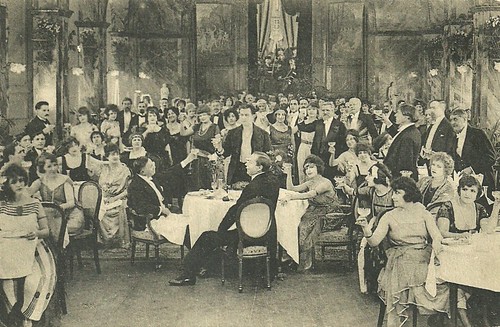
French postcard by M. Le Deley, Paris. Photo: Pathé Consortium Cinéma. Publicity still for L'empereur des pauvres/The Emperor of the poor (René Leprince, 1921). Standing in the middle, Léon Mathot.

French postcard by M. Le Deley, Paris. Photo: Pathé Consortium Cinema. Gina Relly and Léon Mathot in the French silent film L'empereur des pauvres (René Leprince, 1921), an adaptation of the novel by Felicien Champsaur.
When he sensed that his star was descending, Léon Mathot started to combine acting with directing, first with Carmine Gallone Celle qui domine/The one who dominates (Carmine Gallone, Léon Mathot, 1927) and afterwards with André Liabel Dans l’ombre du harem/In the Shadow of the Harem (André Liabel, Léon Mathot, 1928), L’appassionata (André Liabel, Léon Mathot, 1929) with Fernand Fabre and L’instinct/Instinct (André Liabel, Léon Mathot, 1930) with Madeleine Carroll.
When sound cinema became the norm in French cinema, Mathot exclusively focused on film direction. He performed only twice again: in Passeport 13.444/Passport 13444 (1931) which he directed himself, and in Deuxième Bureau contre Kommandantur/Military Intelligence Service against kommandantur (René Jayet, Robert Bibal, 1939), his last role as actor.
In the 1930s he first directed various vehicles for the comic singer Georges Milton such as La bande à Bouboule/Bouboule's Gang (Léon Mathot, 1931) about a carefree Parisian taxi driver, Bouboule 1er roi des nègres/Bouboule the first, king of the negroes (Léon Mathot, 1933), and Le comte Obligado/Count Obligado (Léon Mathot, 1935).
He also directed La Mascotte/The Mascot (Léon Mathot, 1935), an operetta adaptation for the comedian Armand Dranem. He then focused on spy films, and filmed two of the four adventures of Capitaine Benoît based on the novels by Charles-Robert Dumas: Les loups entre eux/Wolves between them (Léon Mathot, 1936) and L’homme à abattre/A Man To Kill (Léon Mathot, 1937).
Mathot then switched again, adapting Gaston Leroux’ Chéri-Bibi (Léon Mathot, 1938), starring Pierre Fresnay. According to Ciné-Ressources, it is one of Mathot’s best films. A year later Mathot also adapted Maurice Larroy’s novel Le révolté/The Rebel (Léon Mathot, 1938), which was scripted by the young Henri-Georges Clouzot.
Former child star René Dary played one of his first serious roles in this film, and four years later, Mathot would direct Dary again in Forte tête/Strong head (Léon Mathot, 1942). After a short return to comedy with Le bois sacré/Sacred Woods (Léon Mathot, 1939) starring Elvire Popesco, Mathot filmed Rappel immédiat/Immediate Call (Léon Mathot, 1939) with Erich von Stroheim and Mireille Balin, a striking spy film.
He also tried his luck with exotic melodrama in Aloha, le chant des ïles/Aloha (Léon Mathot, 1937) starring Arletty, and showed interest in nomads with Cartacalha, reine des gitans/Cartacalha, Queen of the Gypsies (Léon Mathot, 1941) which confirmed the career of Viviane Romance. That same year, the critics appreciated Mathot’s adaptation of Alphonse Daudet’s Fromont jeune et Risler aîné/Fromont junior and Risler senior (Léon Mathot, 1941) with Mireille Balin.
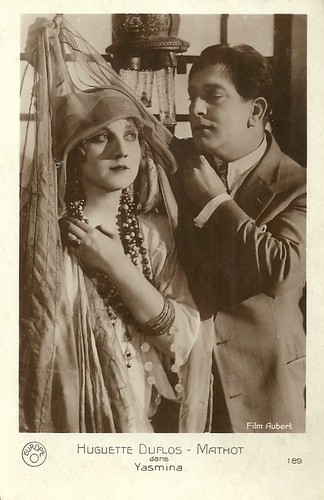
French postcard by Europe, no. 189. Photo: Film Aubert. Publicity still of Huguette Duflos and Léon Mathot in Yasmina (André Hugon, 1927).
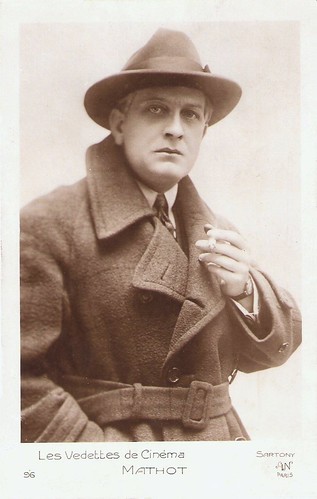
French postcard by A.N., Paris, series Les Vedettes de Cinéma, no. 96. Photo: Sartony.
After the war Léon Mathot alternated melodrama such as La route du bagne/The road to the penal colony (Léon Mathot, 1945) starring Viviane Romance, with ‘film policiers’ like Le dolmen tragique/The tragic dolmen (Léon Mathot, 1948) starring Paulette Dubost, and adventure such as La dernière chevauchée/The last ride (Léon Mathot, 1948) with Mireille Balin and Jacques Dumesnil.
Mathot also shot a pseudo-biography of Marcel Cerdan, L’homme aux mains d’argile/The man in the hands of clay (Léon Mathot, 1949) played by the famous boxer himself.
After having supervised La rue sans loi/The Lawless Street (1950), directed by Marcel Gibaud, Mathot finished his career with a return to comedy: Mon gosse de père/My Childish Father (Léon Mathot, 1953).
Mathot was vice-chair (1938-1959) and later chair of the Cinémathèque française (1959-1967). He was also chairman of the l’Union Européenne des Techniciens du Film et de la Télévision. Léon Mathot died in 1968 in Paris, at the age of 82.

French postcard by A.N., Paris, no. 252. Photo: Production Natan.
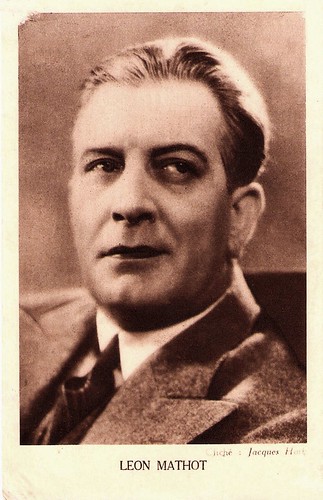
Dutch postcard by N.V. De Faam, Breda. Photo: Jacques Haik.
Sources: Jean-Pascal Constantin (Les Gens du Cinéma - French), Ciné-Ressources (French), Wikipedia (French), and IMDb.

French postcard by Cinémagazine-Edition, Paris, no. 389.

French postcard by Cinémagazine-Edition, no. 15. Photo: Pathé Consortium Cinéma.

French postcard by M. Le Deley, Paris. Photo: Pathé Consortium Cinéma. Publicity still for L'empereur des pauvres/The Emperor of the poor (René Leprince, 1921).
An Overnight Star
Léon Désiré Joseph Mathot was born in Roubaix, France in 1886. After passing his youth in Liège, Belgium, and following the Conservatory there, he started to play on stage in Lyon, and later in Brussels and Paris.
Thanks to his friend Lucien Nonguet who shot short comedies at Pathé, Mathot started in cinema in 1906 as an extra. His first appearance was in the short and silent André Deed comedy La course à la perruque/The Wig Chase (Georges Hatot, André Heuzé, 1906).
Between 1911 and 1914 he played in dozens of the Gontran comedies, often directed by Lucien Nonguet. He also played in dramatic films by directors Henri Andréani and Alfred Machin, mainly for the Belge-Cinéma. During the First World War Mathot switched to the Film d’Art company, where he worked with the young director Abel Gance, such as in Les gaz mortels/Mortal gases (Abel Gance, 1916).
His collaboration with Henri Pouctal started with the film Volonté/Will (Henri Pouctal, 1917) and culminated in the serial Le comte de Monte Christo/The Count of Monte Christo (Henri Pouctal, 1917-1918), which made Mathot an overnight star. Mathot played Edmond Dantès, the leading character in Alexandre Dumas’ classic novel. Dantès takes revenge on the people who ruined and imprisoned him, after he has come into possession of a huge treasure and a new identity.
This success was followed by other films by Pouctal like Travail/Work (Henri Pouctal, 1919), a film in seven chapters taking place at a steel factory, in which Mathot again had the male lead, opposite Huguette Duflos.
Mathot’s reputation only grew during the 1920s while playing in popular French silent films like L'ami Fritz/The Friend Fritz (René Hervil, 1920) again with Duflos, the serial L'empereur des pauvres/The emperor of the poor (René Leprince, 1922) with Gina Relly, the classic drama Cœur fidèle/The Faithful Heart (Jean Epstein, 1923) with Gina Manès, the Honoré de Balzac adaptation L’Auberge Rouge/The Red Inn (Jean Epstein, 1923) again with Manès, Mon oncle Benjamin/My Uncle Benjamin (René Leprince, 1923), Le puits de Jacob/A Daughter of Israel (Edward José, 1926) with American star Betty Blythe, Le mystère de la Villa Rose/Mystery of the Pink Villa (René Hervil, Louis Mercanton, 1930), and La maison de la flèche/The house of the arrow (Henri Fescourt, 1930) with Annabella.

French postcard by M. Le Deley, Paris. Photo: Pathé Consortium Cinéma. Publicity still for L'empereur des pauvres/The Emperor of the poor (René Leprince, 1921). Standing front, Léon Mathot.

French postcard by M. Le Deley, Paris. Photo: Pathé Consortium Cinéma. Publicity still for L'empereur des pauvres/The Emperor of the poor (René Leprince, 1921). Visible are Gina Relly as Sylvette and Léon Mathot as Marc Anavan.

French postcard by M. Le Deley, Paris. Photo: Pathé Consortium Cinéma. Publicity still for L'empereur des pauvres/The Emperor of the poor (René Leprince, 1921). Standing in the middle, Léon Mathot.

French postcard by M. Le Deley, Paris. Photo: Pathé Consortium Cinema. Gina Relly and Léon Mathot in the French silent film L'empereur des pauvres (René Leprince, 1921), an adaptation of the novel by Felicien Champsaur.
Film Direction
When he sensed that his star was descending, Léon Mathot started to combine acting with directing, first with Carmine Gallone Celle qui domine/The one who dominates (Carmine Gallone, Léon Mathot, 1927) and afterwards with André Liabel Dans l’ombre du harem/In the Shadow of the Harem (André Liabel, Léon Mathot, 1928), L’appassionata (André Liabel, Léon Mathot, 1929) with Fernand Fabre and L’instinct/Instinct (André Liabel, Léon Mathot, 1930) with Madeleine Carroll.
When sound cinema became the norm in French cinema, Mathot exclusively focused on film direction. He performed only twice again: in Passeport 13.444/Passport 13444 (1931) which he directed himself, and in Deuxième Bureau contre Kommandantur/Military Intelligence Service against kommandantur (René Jayet, Robert Bibal, 1939), his last role as actor.
In the 1930s he first directed various vehicles for the comic singer Georges Milton such as La bande à Bouboule/Bouboule's Gang (Léon Mathot, 1931) about a carefree Parisian taxi driver, Bouboule 1er roi des nègres/Bouboule the first, king of the negroes (Léon Mathot, 1933), and Le comte Obligado/Count Obligado (Léon Mathot, 1935).
He also directed La Mascotte/The Mascot (Léon Mathot, 1935), an operetta adaptation for the comedian Armand Dranem. He then focused on spy films, and filmed two of the four adventures of Capitaine Benoît based on the novels by Charles-Robert Dumas: Les loups entre eux/Wolves between them (Léon Mathot, 1936) and L’homme à abattre/A Man To Kill (Léon Mathot, 1937).
Mathot then switched again, adapting Gaston Leroux’ Chéri-Bibi (Léon Mathot, 1938), starring Pierre Fresnay. According to Ciné-Ressources, it is one of Mathot’s best films. A year later Mathot also adapted Maurice Larroy’s novel Le révolté/The Rebel (Léon Mathot, 1938), which was scripted by the young Henri-Georges Clouzot.
Former child star René Dary played one of his first serious roles in this film, and four years later, Mathot would direct Dary again in Forte tête/Strong head (Léon Mathot, 1942). After a short return to comedy with Le bois sacré/Sacred Woods (Léon Mathot, 1939) starring Elvire Popesco, Mathot filmed Rappel immédiat/Immediate Call (Léon Mathot, 1939) with Erich von Stroheim and Mireille Balin, a striking spy film.
He also tried his luck with exotic melodrama in Aloha, le chant des ïles/Aloha (Léon Mathot, 1937) starring Arletty, and showed interest in nomads with Cartacalha, reine des gitans/Cartacalha, Queen of the Gypsies (Léon Mathot, 1941) which confirmed the career of Viviane Romance. That same year, the critics appreciated Mathot’s adaptation of Alphonse Daudet’s Fromont jeune et Risler aîné/Fromont junior and Risler senior (Léon Mathot, 1941) with Mireille Balin.

French postcard by Europe, no. 189. Photo: Film Aubert. Publicity still of Huguette Duflos and Léon Mathot in Yasmina (André Hugon, 1927).

French postcard by A.N., Paris, series Les Vedettes de Cinéma, no. 96. Photo: Sartony.
Film Policier
After the war Léon Mathot alternated melodrama such as La route du bagne/The road to the penal colony (Léon Mathot, 1945) starring Viviane Romance, with ‘film policiers’ like Le dolmen tragique/The tragic dolmen (Léon Mathot, 1948) starring Paulette Dubost, and adventure such as La dernière chevauchée/The last ride (Léon Mathot, 1948) with Mireille Balin and Jacques Dumesnil.
Mathot also shot a pseudo-biography of Marcel Cerdan, L’homme aux mains d’argile/The man in the hands of clay (Léon Mathot, 1949) played by the famous boxer himself.
After having supervised La rue sans loi/The Lawless Street (1950), directed by Marcel Gibaud, Mathot finished his career with a return to comedy: Mon gosse de père/My Childish Father (Léon Mathot, 1953).
Mathot was vice-chair (1938-1959) and later chair of the Cinémathèque française (1959-1967). He was also chairman of the l’Union Européenne des Techniciens du Film et de la Télévision. Léon Mathot died in 1968 in Paris, at the age of 82.

French postcard by A.N., Paris, no. 252. Photo: Production Natan.

Dutch postcard by N.V. De Faam, Breda. Photo: Jacques Haik.
Sources: Jean-Pascal Constantin (Les Gens du Cinéma - French), Ciné-Ressources (French), Wikipedia (French), and IMDb.
No comments:
Post a Comment